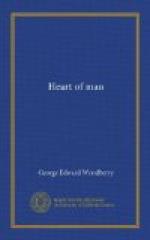In the discussion of type and plot, the concrete nature of the world of art, which was originally stated to be the characteristic work of the creative reason, or imagination acting in conformity with truth, has been assumed; but no reason has been given for it, because it seemed best to develop first with some fulness the nature of that inward order which is thus projected in the forms of art. It belongs to the frailty of man that he seizes with difficulty and holds with feebleness the pure ideas of the intellect, the more in proportion as they are removed from sense; and he seeks to support himself against this weakness by framing sensible representations of the abstract in which the mind can rest. Thus in all lands and among savage tribes, as well as in the most civilized nations, symbols have been used immemorially. The flag of a nation has all its meaning because it is taken as a physical token of national honour, almost of national life itself. The Moslem crescent, the Christian cross, have only a similar significance, a bringing near to the eye of what exists in reality only for the mind and heart. A symbol, however, is an arbitrary fiction, and stands to the idea as a metaphor does to the thing itself. In literature the parable of the mustard seed to which the kingdom of heaven was likened, exemplifies symbolical or metaphorical method; but the tale of the court of Arthur’s knights, ideal method; between them, and sharing something of both, lies allegorical method. Idolatry is the religion of symbolism, for the image is not the god; Christianity is the religion of idealism, for Christ is God incarnate. Idealism presents the reality itself, the universal truth made manifest in the concrete type, and there present and embodied in its characteristics as they are, not merely arbitrarily by a fiction of thought, symbolically or allegorically.
The way in which type concretes truth is sufficiently plain; but it may be useful, with respect to plot, to draw out more in detail the analogy which has been said to exist between it and an illustrative scientific experiment. If scientific law is declared experimentally, the course of nature is modified by intent; certain conditions are secured, certain others eliminated; a selected train of phenomena is then set in motion to the end that the law may be illustrated, and nothing else. In a perfect experiment the law is in full operation. In plot there is a like selection of persons, situations, and incidents so arranged as to disclose the working of that order which obtains in man’s life. The law may be simple and shown by means of few persons and incidents in a brief way, as in ancient drama, or complex and exhibited with many characters in an abundance of action over a wide scene as in Shakspere; in either case equally there is a selection from the whole mass of man’s life of what shall illustrate the causal union in its order and show it in action. The process in the epic or prose narrative is the same. The common method of all is to present the universal law in a particular instance made for the purpose.




